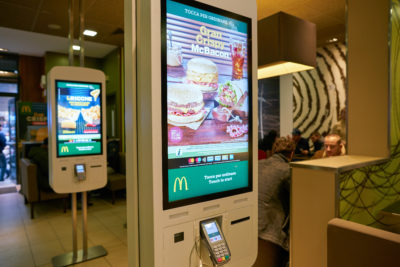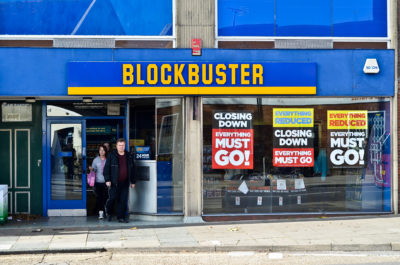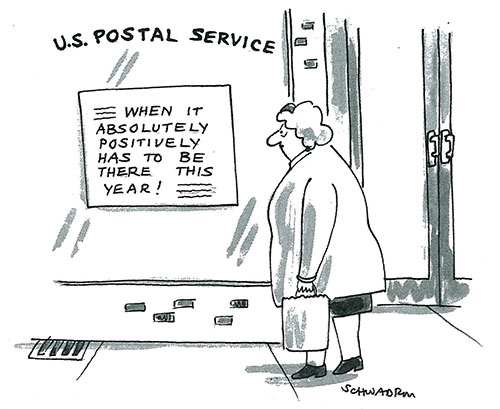11 Common Items That Are Disappearing from Our Everyday Lives
As another year fades into the past, we thought it was a good time to look at a few things that are also becoming history. Some of these familiar items are almost gone, while others are just starting to vanish.
Neighborhood Mail Boxes
As mail volume is dropping, the U.S. Postal Service is adjusting their operations, and part of that move means taking out local drop boxes. Over 12,000 have been removed in the past five years.

Incandescent Lightbulbs
The move to fluorescent and LED bulbs was accelerated in 2014, when the manufacture of energy-inefficient incandescent bulbs was phased out. New LED bulbs last so much longer that General Electric, the company that introduced incandescents to the nation, has decided to leave the light bulb business. When first introduced, LEDs were pricey, but their price has dropped 90% since 2008, all but assuring the death of the incandescent for home use.
Cable TV
In its peak year, 2000, cable television had 68 million subscribers. According to The Atlantic, That number has now dropped to 49 million as more consumers cut the cord and turn to streaming video services like Netflix and Hulu (or old fashioned rabbit ears) for their entertainment.
Bank Branches
Mobile banking has meant convenience for customers, but empty lobbies for banks. The top three national banks, Bank of America, J.P. Morgan Chase, and Wells Fargo, now have over 20 million depositors using mobile banking on their home computers or smart phones. In response, these banks have closed nearly 300 bank branches in the past year. More than 10,000 branches in total have shuttered since the financial crisis, according to The Economist.
Textbooks

Traditional college textbooks can cost more than $200 apiece. To cut costs, students are buying cheaper ebooks, professors are compiling their own course notes electronically, and publishers are offering online courseware. The trend is creeping down the educational chain, as educators replace textbooks in grade and high schools with online media.
DVDs and CDs
It’s significant that computer manufacturers, the people who made CDs and DVDs popular, are now backing away from the technology. Both Mac and PC computers are building units without optical disc drives. Since Windows 8, Microsoft’s operating system no longer is programed to operate an internal DVD player. Consumers are moving their music and movies to cloud storage and relying more on streaming media companies for everything else. For better or worse, the corner video store is already a thing of the past.
Department Stores

Only two major department stores have shown growth over the past ten years: Kohl’s and Nordstrom. Almost all the others are suffering. In the past ten years, J.C. Penney’s revenues have dropped from $20 billion to $12 billion. Sears’ revenues in the same period have dropped from $30 billion to $15 billion. In general, brick-and-mortar retailers are facing hard times. In 2016, 2,400 retail stores announced their closing. In 2017, the number was 5,000. It is expected to hit 7,000 in 2018.
Keys
In the future, you won’t open your front door with a key but with your Bluetooth-enabled smart phone. Two of the biggest lock makers, Kwikset and Yale, are already working on keyless security systems. Auto manufacturers are also developing secure systems for your phone that will unlock and start your car.
Landline Telephones
Today, more than half of American households rely on cellphones instead of landlines. But don’t expect hard-wired phones to disappear too quickly. Businesses that have millions of dollars invested in their phone systems will keep landlines around until they can afford to go cellular.
Restaurant Servers

With Americans happy to order anything online, restaurant owners are starting to replace workers at their front counters with self-service kiosks. Panera Bread is already replacing cashiers with these devices. Some McDonalds have installed touch-screen technology to let customers order their meal or custom-build their burger. Wendy’s is planning to go in the same direction. Olive Garden now has tabletop tablets that allow diners to order and pay at their table without waiting for a server.
Blockbuster Video

With hundreds of their former stores standing empty across the country, Blockbuster Video is considered one of the country’s most noticeable business deaths. Yet the Blockbuster name hasn’t completely vanished. There are 10 operated Blockbuster stores in America; seven are in Alaska.
Featured image: Shutterstock
Meet the Cartoonist: Harley Schwadron
“Sorry, but ‘What happens in Vegas, stays in Vegas’ is not a recognized legal precedent.”

There’s that guy in the pin-striped suit! You’ll see him in The Wall Street Journal, Barrons, and Harvard Business Review—and very often in The Saturday Evening Post. “I started doing business cartoons because I was following the lure of the existing cartoon markets,” says Schwadron (pronounced “Sway-dron”). So the character I’ve dubbed “pin-stripe guy” has been good to him.
“U.S. Postal Service: When it absolutely positively has to be there this year!”

Ouch. The poor post office gets no respect. “My first big cartoon sale when I was starting out was to The Saturday Evening Post!” says Harley. I wonder if it was this one from 1984.
“House protected by not having anything of value inside.”

“I’ve been drawing cartoons since I was eight years old,” Schwadron reports. “However, I never thought I could earn a living at it.” So he got a master’s degree in journalism and worked as a reporter and later editor for Michigan News Service. He drew cartoons in his spare time and “in 1985 I took a chance and started doing cartoons full-time. I’ve been happily at it ever since!”
“The correct response is ‘I do’—not ‘it’s worth a try.’”

Maybe we can place bets on how long this union will last. “There are a lot of rejections,” in the cartoon business, Harley says. “My routine is to turn out a regular amount of cartoons each day, send them out, and hope for the best.”
“Someone in our neighborhood must have won the lottery.”

Good guess based on the appearance of the three major news networks and the IRS. Harley may not have won the lottery, but as a cartoonist, he has arrived: “I recently built a studio on the back of my house. You have to be a ‘serious’ cartoonist to go to the expense and stress of building a home studio.” Another perk of the job: “If I feel like it, I can work in my pajamas and no one cares.”
“This is your captain. In the event of a drop in cabin air pressure, the oxygen mask will drop down, and you will be billed $2 per breath.”

I hesitate to show this cartoon from last year, lest it give the airlines ideas. “My niche seems to be business and topical cartoons,” Harley says. He advises aspiring cartoonists to “do the kind of cartoons you like and to find a niche that you enjoy doing.”
“I don’t care if you’re tired, Gerald. Get down at once!”

Harley lives in Ann Arbor, Michigan, (where, presumably, he behaves himself in grocery stores) with his wife, a psychiatric social worker. They have two grown children.